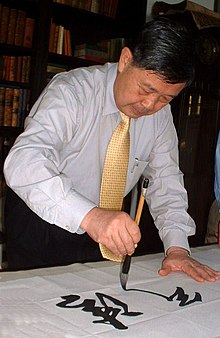Radical 129
| 聿 | ||
|---|---|---|
| 128 ⽿ ◄ | 129 | ► ⾁ 130 |
| Pinyin : | yù 毛筆 máobǐ (= writing brush) |
|
| Zhuyin : | ㄩ ˋ | |
| Hiragana : | ふ で づ く り fudezukuri | |
| Kanji : |
筆 旁 fudezukuri (= radical brush) |
|
| Hangul : | 붓 | |
| Sinocorean : | 율 | |
| Codepoint : | U + 807F |
|
| Stroke sequence : |
|
|

Radical 129 , meaning " writing brush ", is one of 29 of the 214 traditional radicals in Chinese writing that are written with six strokes.
With 5 character combinations in Mathews' Chinese-English Dictionary, there are very few characters that can be found under this radical in the lexicon.
The radical "brush" takes only in the traditional characters - list of traditional radicals consisting of 214 radicals, the 129th position. It can be found in a completely different place in modern abbreviation dictionaries.
The seal- form shows a hand with a brush, so that 聿 can be considered the original form of 笔 (bǐ = brush). (Some experts believe that the original hand held a cloth 巾 jīn instead of a brush). With the pronunciation ni, the variant with only one horizontal line below had the same meaning as 聿, which is why the radical tables usually have both variants. The 肀 ni form denotes the Cihai as 聿 字 头 (yùzìtóu head of the sign 聿). Old dictionaries and the Ciyuan do not use 肀 (ni) as a radical, but only the six-line 聿. 肀(ni) came with abbreviations as a new radical.
肀 ni is exclusively radical and, if it appears as a bearer of meaning, puts its signs in the meaning of “doing something with a brush”, as for example in 肄 (= study). 肃 (in: 严肃 yánsù = seriously; 肃 sù in its seal form shows the hand with a brush or cloth over a deep body of water and this activity above the deep is associated with danger, from which the meaning of respect is derived). In 律 (lǜ = law, rule) 聿 acts as a sound carrier next to the double human, 彳. In 建 (jiàn = to build) the components 廴 (as a remnant of 廷 ting = ruler's court) and 聿 as a remnant of 律 (lǜ) can be found. The original meaning of 建 (jiàn) is to establish a dynasty . 聿 only acts as a general component here.
Spelling variants: 肀 (four lines), ? and ⺻ (five lines), 聿 (six lines).
Character combinations ruled by radical 129
| Strokes | character |
|---|---|
| + 0 | 聿 肀
|
| + 4 | 肁 肂 肃
|
| + 5 | 粛
|
| + 7 | 肄 肅 肆
|
| + 8 | 肇 肈 |
In the Unicode block Kangxi radicals , radical 129 is coded under the code point number 12.160 (U + 2F80).
literature
- Edoardo Fazzioli : Painted Words. 214 Chinese characters - from picture to concept . Marixverlag, Wiesbaden 2004, ISBN 3-937715-34-7 , p. 143 .
- Cecilia Lindqvist : A world of signs - about the Chinese and their writing . Droemer Knaur, Munich 1990, ISBN 3-426-26482-X , p. 306 .
- For detailed references, see List of Traditional Radicals: Literature
Web links
- Xiù cai.oai.de (PDF; 1.72 MB) Explanation of Radikal 129 on page 86
